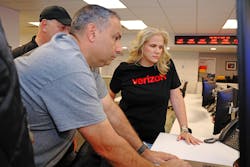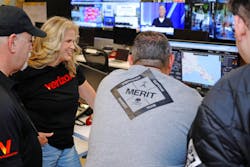Executive Insights with ISE EXPO’s Opening Keynote Presenter, Julie Slattery, SVP, Core Engineering & Operations, Verizon
Verizon doesn’t just build and run networks—they redefine what networks can do. As SVP of Core Engineering & Operations at Verizon, Julie Slattery leads a team that delivers and supports one of the industry’s most ambitious transformations: unifying fiber, 5G, satellite, fixed wireless, and legacy infrastructure into a smarter, faster, more resilient ecosystem.
But Julie's leadership goes beyond technology. She’s deeply invested in people—empowering teams, strengthening communities, and building a culture of innovation that’s ready for anything. In this Q&A, Julie gets real about the challenges and breakthroughs shaping today’s networks, the power of AI, and why listening may be the most underrated leadership skill of all.
We use AI extensively in network planning, deployment, and operations. This includes resource optimization, coverage optimization, scheduling optimization, and performance/usage assessment through our AI-powered Network Genie tool.
Topic: Mixed Infrastructures
ISE: Fiber, FWA, LEOs, 5G, legacy copper, and other connectivity options are being leveraged by network providers today. How does that complicate your teams’ jobs, and what is the answer to simplify those networks in the near future?
Julie Slattery: Simplifying networks involves prioritizing virtualization and software-defined networking. This enables better management and integration of diverse technologies. In the ever-evolving telecommunications landscape, Verizon has consistently been at the forefront, pioneering the deployment and operation of our network on a fully virtualized platform. We’ve been aggressively deploying Virtualized Radio Access Network (V-RAN) technology across our network to enhance flexibility, efficiency, and performance.
Network virtualization involves decoupling network functions from proprietary hardware, allowing them to run as software on standardized hardware platforms. This transformation offers several key advantages including scalability and flexibility, rapid deployment, cost efficiency and enhanced reliability.
By embracing virtualization, we’ve been able to respond swiftly to customer needs, laying the foundation to allocate precise resources to each network function at the exact time they are required. Our virtualized network architecture has been instrumental in supporting emerging technologies and services, including the rollout of 5G and fixed wireless access (FWA) solutions.
Topic: The AI Buzz Versus Network Realities
ISE: For over a decade, Verizon has strategically integrated AI into its operations, enhancing internal efficiencies, elevating customer experiences, and optimizing the network infrastructure. Share how your Network Operations team has realized using AI to support fault and performance management, forecast and optimize resource utilization, and mitigate risks across Verizon’s network.
Slattery: At Verizon, we see ourselves not just as participants in the AI-driven future, but as the backbone of the emerging AI economy, enabling its success. A fundamental aspect of using AI effectively is a virtualized network architecture. This enables the rapid deployment of new services, immediate reconfiguration, fault isolation, automated self-healing, and virtualized security functions. We use AI extensively in network planning, deployment, and operations. This includes resource optimization, coverage optimization, scheduling optimization, and performance/usage assessment through our AI-powered Network Genie tool.
We recently announced results from a trial that demonstrated yet another way AI is being used in our network to drive operational efficiency and ensure Verizon customers are always connected to the very best network experience.
By using Samsung’s AI-powered Energy Saving Manager (ESM) in combination with our virtualized network and Qualcomm’s AI controller, we were able to realize significant energy savings while maintaining reliable and stable network performance during low traffic times. The AI engine analyzes commercial network traffic patterns and recommends the most effective way to conserve energy, even automatically turning cells on and off, illustrating just how helpful AI can be in helping us optimize our network precisely and intelligently.
Topic: Fiber Expansion
ISE: As demand for high-capacity, low-latency networks continues to grow, how is Verizon approaching fiber expansion, and what should infrastructure vendors expect in terms of opportunities and challenges ahead?
Slattery: Fiber is the backbone of everything. It supports our 5G network, home broadband products, enterprise services, and the growing demands of consumers. We continue to make significant investments in fiber infrastructure to meet the ever-increasing demand for high-speed, low-latency connectivity. We are doing this through direct builds and through acquisitions.
Fiber builds are complex and capital-intensive, requiring significant coordination with local governments and infrastructure partners, which is why we take a collaborative approach to deployment. We are working with contractors, municipalities, and regulators to streamline fiber expansion. We’re always looking for best-in-class solutions and cost efficiency. The ongoing demand for fiber creates significant growth opportunities for contractors, engineers, and those involved in deployment and maintenance.
Topic: Satellite Technology
ISE: How do you view the role of satellite in the broader connectivity ecosystem, and should the industry be thinking of it as a partner or a competitor to terrestrial networks?
Slattery: Our focus remains on delivering reliable, cutting-edge networks that meet the growing demands of customers, businesses, and industries. We continually strive to adopt new technologies. From AI to fiber to hybrid networks, we’re investing in the innovations that will power the future of connectivity. That includes augmenting our network with satellite coverage.
Today, we offer satellite direct-to-device technology, allowing customers with compatible devices to send text messages to any other customer's device via satellite, even when terrestrial cellular network service is interrupted. While satellite connectivity is rapidly improving, "true broadband" experiences are still primarily delivered through terrestrial cellular networks due to technological and capacity constraints. Terrestrial cellular networks will always provide the most robust, reliable, superior wireless connections available. Satellite capacity is limited, which restricts the types of services that can be offered. Space-based cellular will continue to complement terrestrial networks.
Topic: Partnerships
ISE: Share three best practices you recommend for improving community partnership programs.
Slattery: It’s essential to be fully rooted in a community for a while before partnering and ideating. To ensure a holistic approach, we’re there primarily to learn and listen before acting.
Best practices include transparent communication, shared goals, and mutual respect. Also, avoid unilateral decisions and be cognizant of local issues and concerns.
We are always open to hearing new voices and ideas from a community and look to develop programs that incorporate the experience and learnings of established industry professionals and the communities we serve.
Topic: Powering the Future
ISE: Technological innovations in power and energy storage solutions allow operators to improve network resilience. However, unforeseen circumstances often challenge the best plans. Describe the nuts and bolts behind Verizon’s network strategy that address the reality of a fallible power grid, especially in times of natural disasters.
Slattery: With built-in backup power, redundant fiber routes, and hardened infrastructure, our network is designed to withstand the harshest conditions. To maintain connectivity in the event of commercial power loss, 100% of Verizon’s macro cell sites have backup battery power. In addition to permanent generators at critical network facilities and cell sites, we have mobile generators on standby. Our engineers prepare for events by conducting thorough checks and ensuring that backup systems, such as batteries and generators, are always operational and properly refueled.
We also have thousands of network and satellite assets ready to deploy to the hardest-hit areas, serving as mobile cell sites, temporary emergency command centers, and self-contained base camp operations.
Finally, partnership is key. We meet with power companies year-round so that when an event occurs, we have open lines of communication and can express our collective needs, working together as a team. We find out where their critical locations are so we can help them restore power, which also helps us get our sites back on the air.
Topic: Verizon Military Training Partnership
ISE: Verizon has partnered with the U.S. military in extreme training scenarios to prepare for responding to natural disasters. Your Emergency Response Team (ERT) includes technicians and engineers specializing in restoring fiber connections. Share an example of how this extreme training helped your team dramatically improve their processes and results when responding to a recent emergency.
Slattery: Across the country, we have teams of highly specialized engineers and technicians who train throughout the year in HAZMAT, disaster response, and incident management. The training is vital to ensure they are prepared to respond to disasters at a moment's notice to rapidly restore connections under pressure. By training alongside other agencies such as the military in simulated crisis scenarios, we’re able to sharpen our skills and share key learnings.
We recently participated in the 2025 Patriot Drill, a joint training operation involving the National Guard, the Georgia State Defense Force, and various other federal and state agencies. The Patriot training scenarios include road and debris clearing, flooding and erosion response, search and rescue operations, chemical and radiological response operations, air medical evacuations and drone support.
We recently put that training into action, utilizing our hazmat skills after three retail stores in Asheville, North Carolina, were impacted by hazardous materials, potential waste, mud, and floodwaters. Our network technicians applied their specialized hazmat training to safely recover salvageable inventory and get it back into service, demonstrating a valuable skill set beyond their usual network responsibilities.Drones have also become increasingly important. Drone 3D modeling opens the door to faster restoration by reducing the number of tower climbs that are required following a major event like a hurricane. Drones also serve as flying cell sites, whether tethered drones or large drones with low earth orbit (LEO) satellites for backhaul, which opens the door to creating emergency coverage anywhere it is needed.
Topic: Your Keynote Takeaways
ISE: Your keynote title is: Building Resilient Communities: Enhancing Disaster Preparedness and Response Through Technology, Innovation, and Partnership. While Verizon has many resources to excel in this area, what are three takeaways small-to-medium-sized network providers will leave with after attending your keynote?
Slattery: Small and medium-sized providers should focus on proactive planning, training, and leveraging partnerships to share resources and receive support.
This starts with preparing for the worst before it happens. Excellence in this area involves advanced planning and continual review of plans for the strategic coordination of people, processes and technology on a 24/7 basis. It’s also about having pre-incident, incident, and post-incident checklists, and ensuring all your contacts are up to date so you always know who to reach out to in a time of crisis. They should also concentrate on upskilling their workforce through continual training to respond to disasters or threats, and regularly review, reassess, and evolve their business continuity plans.
Companies then need to apply all their learnings to improve and enhance their preparedness and recovery strategies. It’s also important to stay on top of advancements in technology to ensure you're making the most of all the latest tools in your toolbox, like predictive analytics, machine learning, and AI.
Finally, it’s about leaning into disaster planning and preparation, together. As with all phases of disaster resilience, partnership is key. It’s critical to build strong relationships with vendors, the public safety community and other key stakeholders.Topic: Talent Engagement and Retention
ISE: Nearly three-quarters of employers, 71%, still struggle to find skilled talent,1 according to ManpowerGroup’s latest talent shortage survey. IT and data skills remain the most challenging, cited by 23% of respondents, followed by operations and logistics at 21% and sales and marketing at 20%, reflecting the ongoing digital transformation across industries. Once Verizon hires these in-demand, talented folks, the trick is engaging and retaining them. How does your team retain and upskill its great team members?
Slattery: Our V Team is our greatest asset, and we're heavily invested in their growth and success. We prioritize their engagement, continuous training, and skill development, as well as career growth, by providing tools (created with the help of AI) that help them plan their careers, identify the skills needed for future roles, and access personalized training suggestions. Whether someone wants to grow in their current role or explore new paths, extensive learning resources and our tuition assistance benefits are available.
We work to identify and nurture leaders early on and actively promote internal mobility as well, making it easier for our people to explore different roles across the company and build “lattice” careers for broader experience. And we know this approach works: about one in three internal moves at Verizon is to an entirely different job family.
Our focus on team growth and promoting a supportive, inclusive culture directly leads to higher engagement, empowering our employees to build rewarding, long-term careers—a fact demonstrated by our 13-year average employee tenure.
Topic: Innovation
ISE: What are some recent tech advancements that you are excited about that are helping in disaster recovery and response?
Slattery: To help first responders, we recently launched the Verizon Frontline Network Slice, a 5G Ultra Wideband virtual network slice dedicated entirely to public safety. This allows for the allocation of network resources within Verizon’s network infrastructure. This helps provide first responders with several key advantages, including dedicated 5G Ultra Wideband network capacity reserved exclusively for them, which helps ensure network resource availability and priority, as well as enhanced quality of service. It also enables tailored performance for critical applications and devices, helping to ensure data traffic is optimized for the operational needs of first responders. This enhanced reliability significantly reduces the risk of disruption to mission-critical communications, even during periods of high network congestion.
Drones have also become increasingly important. Drone 3D modeling opens the door to faster restoration by reducing the number of tower climbs that are required following a major event like a hurricane. Drones also serve as flying cell sites, whether tethered drones or large drones with low earth orbit (LEO) satellites for backhaul, which opens the door to creating emergency coverage anywhere it is needed.
And of course, AI opens endless opportunities to accelerate how we prepare and respond. Today, we leverage AI to help prioritize recovery areas and showcase sites that may not be performing optimally. The future of AI in disaster response will involve prioritizing sites for recovery and rapidly adjusting the plan as sites are restored.
Topic: Results
ISE: Share one story about your team crushing an objective this year.
Slattery: We’re always focused on providing the best and most reliable network experience for our customers and are always looking for ways to make their lives easier, whether at home or on the go. I’m proud of my team’s work developing a new tool that enhances the customer experience by offering greater network transparency. The Check Network Status tool, available on the web and in the My Verizon app, lets customers see exactly what’s going on with their service.
With Check Network Status, we’re giving customers visibility into updates on the network status in their area and empowering them to provide direct feedback to the engineers who build and operate our network. Through this tool, we can communicate with customers about upcoming network upgrades in their area, as well as provide estimated times of resolution for any issues, such as storm-related outages. Our engineers have access to the data and insights provided from this direct customer feedback as they make decisions about building and operating our network.
By providing greater transparency into customers’ network experience, we can listen to our customers’ feedback and respond to their needs.
Topic: 5G Evolution
ISE: 5G has already transformed the industry. But as we move beyond the initial deployment phase, what’s next?
Slattery: We’re continuing to expand C-band coverage and plan to reach 90% of the country this year. As we shift from deployment, we’re actively optimizing our network with 5G advanced technology, high-speed fiber, edge computing and intelligent management to efficiently handle the massive data demands of real-time applications, seamless cloud connectivity, and data-intensive demands of AI-driven workloads. These advanced technologies are enhancing the customer experience and improving the efficiency and costs associated with network management.
This will drive new services that involve network slicing and edge computing, which are unlocking customized, low-latency solutions for businesses. To that end, we’ve seen continued demand for private 5G networks, and we believe that network slicing will unlock more opportunities in the enterprise space.
Finally, we’re continuing to expand access to and performance of FWA which was one of the big use cases that emerged with 5G. We expect to hit 8 to 9 million fixed wireless broadband subscribers by 2028.
When it comes to soft skills, one I value the most is listening. We don’t have all the answers, and we don’t even know all the problems to work on. We must take the time to truly listen to the teams, the challenges they face, and the ideas they have, so we can effectively advocate and support where needed.
Topic: Company Culture
ISE: Culture influences nearly every aspect of a company, and both employees and leaders experience its impact daily. However, bridging the divide between executive leadership and the general workforce can sometimes be tough. Share two strategies you use to nurture your team’s culture.
Slattery: Two critical strategies are encouraging open communication and recognizing team achievements. Keeping open communication with our frontline employees is a vital part of success. My leadership team often holds skip-level meetings so leaders can hear from employees at various stages in their careers and from different parts of the organization. We are deliberate in spending a lot of time out of the office and in the field, as well as in centers with the team, listening and hosting town halls. They bring innovative ideas and highlight issues for us to address.
We also use regular Pulse surveys that allow employees to share open and honest feedback. Our leadership team takes these surveys extremely seriously, reading all employee comments and developing action plans to address areas for improvement.
When it comes to recognition, we know everyone wants to feel seen and appreciated for the time and effort they dedicate to the company day in and day out. To achieve this, we offer several monthly awards that recognize employees who consistently go above and beyond to ensure network reliability and provide strategic problem-solving and leadership skills.
Topic: Constant Growth
ISE: What soft skills and leadership strategies are essential for your team members to succeed in this ever-evolving industry?
Slattery: When it comes to soft skills, one I value the most is listening. We don’t have all the answers, and we don’t even know all the problems to work on. We must take the time to truly listen to the teams, the challenges they face, and the ideas they have, so we can effectively advocate and support where needed.
To prepare team members for career growth and leadership opportunities, I encourage them to get comfortable with change and continuously learn from their peers and leaders. As technologists, we must stay current with the latest developments. There is a great deal of education out there in the form of courses, certifications, white papers, and other written material, and opportunities for on-the-job and/or peer-led development and mentorship. Future leaders need to take risks and embrace opportunities to move out of their comfort zone into a role that will build upon their skills.
Topic: Leadership Style
ISE: Share one word that encapsulates your leadership style.
Slattery: Authenticity. Being genuine, honest, and transparent is essential to building trust and serving and leading teams. It’s also important to listen to understand team challenges and empower them to take the initiative and make decisions effectively. To do this, you need to create a safe, inclusive environment where all members feel free to share their ideas and struggles.
When you have a foundation of trust, people are more open to giving and receiving constructive feedback and providing honest thoughts. I’m passionate about developing future leaders, so I encourage and mentor talent at all levels, sharing my personal experiences and career journey to inspire them to take on projects or roles that will stretch their skills and provide future opportunities for advancement.
Topic: Balance
ISE: What are your thoughts about work/life balance?
Slattery: Work/life balance is crucial for long-term success and personal well-being. As a mother and wife, I know that balancing work and family is no small feat, and it takes dedication and mindfulness to find that healthy balance. But when you know you have a team and leaders who support you when personal challenges arise, it can make all the difference.
That’s why I emphasize to my team members to take the time to focus on their mental and physical health, avoiding stress and burnout, which ultimately enhances everyone’s productivity and job satisfaction. We all need to enable people to recharge so they can approach their work every day with renewed focus, energy and motivation.
Topic: Legacy
ISE: What do you hope your professional legacy is when you’re comfortably retired on a tropical island?
Slattery: To leave our business strong and thriving in the hands of a new generation of outstanding leaders, whom I hope to have impacted in some way.
REFERENCE
1. Talent shortage survey, https://www.staffingindustry.com/news/global-daily-news/talent-shortages-still-challenge-us-employers
Julie Slattery leads a team of nearly 4,500 network engineers and technicians who build and operate the most reliable, highest performing and secure networks for Verizon’s customers, including deployment of the 5G core. Her team is also responsible for Verizon's business continuity program, ensuring that Verizon can serve customers and keep them connected when it matters most. Throughout her tenure at Verizon, Julie has held a variety of leadership positions of increasing responsibility across engineering, operations, and customer experience. She has led large, global organizations serving Verizon’s wholesale, multinational enterprise, and consumer customers. For more information, visit www.verizon.com.
Join us at ISE EXPO 2025 to hear more from Julie! CLICK HERE to learn more and to register.
About the Author
Sharon Vollman
Content Ambassador for ISE EXPO
Sharon Vollman is the Content Ambassador for ISE EXPO. She is passionate about collaborating with thought leaders, SMEs and hard-working doers who design, plan and deploy ultra-reliable broadband networks. Vollman is committed to creating a variety of educational offerings for ISE EXPO attendees that inspire them to connect every U.S. citizen with the broadband networks we all want for our children and grandchildren.
Vollman has created educational partnerships with Broadband Service Providers including AT&T, Verizon, Lumen, Frontier Communications and others. She has covered the telecom industry since 1996.





